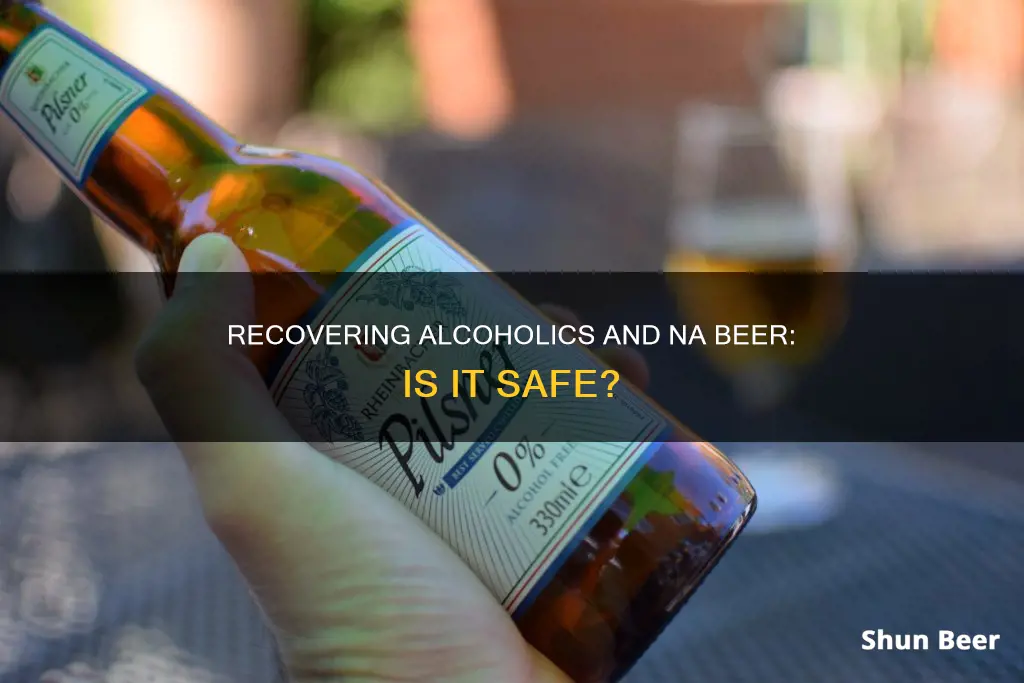
Non-alcoholic beer is an increasingly popular option for those who want to cut down on their alcohol consumption or quit drinking altogether. But is it a safe choice for people in recovery from alcoholism? Non-alcoholic beer, or near beer, typically contains up to 0.5% alcohol by volume (ABV), which is not enough to cause intoxication. However, the taste, smell, and appearance of non-alcoholic beer can be a powerful trigger for recovering alcoholics, potentially leading to cravings and relapse. While some people in recovery may choose to consume non-alcoholic beer without issue, others may find it too risky. Ultimately, the decision is a personal one, and individuals must weigh their own motives, triggers, and recovery journey before making a choice.
| Characteristics | Values |
|---|---|
| Alcohol content | Non-alcoholic beer contains up to 0.5% alcohol by volume (ABV) |
| Trace amounts of alcohol | Even trace amounts of alcohol can trigger cravings and lead to a relapse |
| Taste and smell | The taste and smell of non-alcoholic beer can trigger "euphoric recall", where the positive memories of drinking are reactivated |
| Social inclusion | Non-alcoholic beer can help recovering alcoholics feel included in social events where alcohol is served |
| Individual differences | The decision to consume non-alcoholic beer during recovery depends on individual triggers and limits |
What You'll Learn

Non-alcoholic beer can trigger a relapse
Non-alcoholic beers (NABs) may seem like an appealing option for recovering alcoholics. After all, they don't cause drunkenness and the associated problems such as reckless behaviour, impaired judgement, or blackouts. However, NABs can be a powerful trigger, creating cravings that can lead to a relapse.
NABs still contain alcohol
Most NABs contain trace amounts of alcohol, typically around 0.5% alcohol by volume (ABV), compared to the average 5% ABV of alcoholic beer. While this is a minuscule amount, it can pave the way for rationalising the consumption of stronger drinks.
The sensory experience can be a trigger
The look, smell, and taste of NABs are identical to regular beer. The sensory experiences associated with drinking beer, minus the intoxicating effect, can be a significant trigger for someone in recovery. This can cause frustration and trigger a condition known as "euphoric recall".
NABs can be a behavioural crutch
Recovering addicts must work every day to avoid a relapse. This includes avoiding people, places, and things associated with their drinking habit, and establishing new hobbies, friendships, and behaviours that don't revolve around drinking. NABs can serve as a "behavioural crutch", providing a sense of familiarity and comfort that can lead to a slippery slope back into drinking alcoholic beverages.
NABs may indicate unresolved issues
The desire to drink NABs may indicate that a person is not fully committed to their recovery or has not addressed the underlying reasons for their substance abuse problem. It may suggest the need for additional support and accountability in their recovery journey.
NABs can lead to a slippery slope
The taste and appearance of NABs are very similar to regular beer. For some individuals, this sensory experience can be a powerful trigger, bringing back memories of drinking and triggering a relapse. The act of drinking NABs can normalise the behaviour of drinking and make it easier to justify having an alcoholic beverage.
NABs can activate old habits and cravings
When alcoholics drink NABs, it can activate old habits, thoughts, and patterns associated with drinking. This can cause their brain and body to fall back into addictive behaviours, leading to cravings and compulsive behaviour.
In conclusion, while NABs may seem harmless, they can pose a significant risk for recovering alcoholics. The decision to consume NABs should be made with caution and a thorough understanding of one's triggers and commitment to recovery.
After-work beer: A harmless habit or a slippery slope?
You may want to see also

NA beer still contains some alcohol
Non-alcoholic beer, sometimes called "near beer", is a brewed beverage that is modelled after flavorful craft beers. It is made using the same basic ingredients as conventional beer—water, yeast, hops, and grain—and it goes through a similar fermentation process. However, the key difference is that the alcohol is removed at the end, resulting in a drink with very little or no alcohol content.
According to US regulations, beverages with up to 0.5% alcohol by volume (ABV) can be labelled as "non-alcoholic". This means that technically, non-alcoholic beers can contain small amounts of alcohol. In comparison, a standard beer typically has around 5% ABV. While this low percentage of alcohol in non-alcoholic beer is not enough to cause intoxication, it is important to understand that it is not completely alcohol-free.
The amount of alcohol in non-alcoholic beer can vary, and some products may contain more alcohol than their labels indicate. A 2010 study published in the Canadian Journal of Clinical Pharmacology found that out of 45 NA beers tested, 29% had higher alcohol levels than declared on their labels. Additionally, six beverages claiming to be alcohol-free were found to contain more than 1% ethanol.
The presence of alcohol, even in trace amounts, can be a concern for individuals who are pregnant, trying to become pregnant, or recovering from alcohol use disorder. For these individuals, it is crucial to understand that non-alcoholic beer may still contain some alcohol, and consuming it could potentially lead to a relapse or pose other health risks.
The smell and taste of non-alcoholic beer, which are very similar to regular beer, can also be powerful triggers for people in recovery. The sensory experience can evoke euphoric recall, where a recovering addict glamorizes their past drinking habits while ignoring the negative consequences. This can lead to cravings and increase the risk of relapse.
Therefore, while non-alcoholic beer may be a suitable option for some people, it is important to be aware of its potential risks, especially for those with alcohol use disorders or those who are pregnant. It is always advisable to check the labels and be mindful of the amount of alcohol consumed, even in products labelled as "non-alcoholic".
Cemetery Drinking: Is Beer Allowed on Sacred Grounds?
You may want to see also

The taste and smell of NA beer can be triggering
The taste and smell of non-alcoholic beer can be a powerful trigger for recovering alcoholics. The look, smell, and taste of non-alcoholic beer are almost identical to those of regular beer, and this can be a significant trigger for someone in recovery. The same sensory experiences associated with drinking beer, without the intoxicating effect, can cause frustration and a condition known as euphoric recall. Euphoric recall is a form of selective memory in which a recovering addict glamorizes their active addiction while ignoring all the negative effects it had on their life.
The smell of beer may serve as a relapse trigger. In a research study, a team of California scientists reported that the smell of beer may be enough to trigger cravings and a subsequent relapse among certain people with alcohol use disorder. The researchers found increases in dopamine in the rats' brains before and after smelling these "alcohol-related cues". While this was an animal study, it suggests that the taste and smell of non-alcoholic beer can be triggering for recovering alcoholics.
Non-alcoholic beer can trigger cravings and potential relapse for people in recovery from alcohol addiction. The smell and taste of non-alcoholic drinks may trigger memories of drinking beer and increase dopamine levels in the brain, which may lead to a desire for actual alcohol. This can complicate long-term sobriety and even lead to binge drinking or relapse. The psychological and physical impact of even small amounts of alcohol can be harmful to those in recovery.
The taste and smell of non-alcoholic beer can be particularly triggering for people in early recovery. The urges and triggers it creates can be too powerful, and it's best to stay on the safe path and avoid non-alcoholic beer altogether. Recovering alcoholics should be cautious when considering non-alcoholic beer as it can compromise their sobriety. Relapse among some individuals can be a devastating but avoidable event. It's important for recovering individuals to weigh the risks and benefits carefully while looking for other options that don't simulate the experience of drinking beer so closely.
Is Day-Old Beer Safe to Drink?
You may want to see also

NA beer can act as a behavioural crutch
Drinking NA beer can be a negative influence on a person's ability to cope with an alcohol-free lifestyle. It can be a stumbling block on the road to recovery, rather than a stepping stone towards sobriety. This is because NA beer can trigger cravings for alcoholic drinks, as the individual is still engaging in the behaviour of drinking.
The smell and taste of NA beer can be powerful triggers for cravings, as the senses are fooled into thinking they are consuming an alcoholic drink. This is especially true for NA beers that taste very similar to their alcoholic counterparts.
Additionally, NA beer can romanticise drinking. It puts the beverage on a pedestal and suggests that there is nothing else in the world the individual would rather be consuming. This can be dangerous for alcoholics, as it keeps their minds focused on alcohol.
For these reasons, it is generally recommended that recovering alcoholics avoid NA beer and find new hobbies outside of drinking culture. It is important for them to break free from the behavioural crutch that NA beer can provide and fully embrace an alcohol-free lifestyle.
Mixing Beer and Liquor: Safe or Not?
You may want to see also

NA beer may not be worth the risk to sobriety
Non-alcoholic beer, or NA beer, is a brewed beverage that looks, smells, and tastes like regular beer but only contains trace amounts of alcohol. While it is almost impossible to get drunk off NA beer, it is not recommended for people in recovery from alcohol addiction.
- It can trigger cravings and relapse: The taste, smell, and appearance of NA beer can be powerful triggers for people in recovery, creating cravings that can lead to a relapse. The risk of sacrificing one's sobriety is not worth it.
- It contains some alcohol: Most NA beers contain around 0.5% alcohol, and some may even have higher levels than advertised. While it's unlikely to cause intoxication, it can still be a trigger and potentially lead to rationalizing having a stronger drink.
- It can act as a behavioral crutch: Recovery from addiction involves creating new habits, meeting new people, and engaging in new activities. Drinking NA beer can become a crutch that keeps people tied to their old drinking habits and triggers cravings.
- It can lead to "euphoric recall": NA beer can trigger euphoric recall, a form of selective memory where a recovering addict glamorizes their past drinking while ignoring the negative consequences. This can intensify cravings and increase the risk of relapse.
- It may indicate a lack of dedication to recovery: The desire to drink NA beer may be a sign that the person is not fully committed to their recovery or has not addressed the underlying reasons for their substance abuse. It may indicate a need for a more structured and accountable environment.
While the decision to drink NA beer is ultimately a personal one, it is crucial for people in recovery to be aware of their triggers and make informed choices. The potential risks of NA beer on one's sobriety may outweigh the benefits.
Beer and Diverticulitis: What You Need to Know
You may want to see also
Frequently asked questions
Non-alcoholic beer still contains a small amount of alcohol, and medical professionals advise staying away from it. Even a small amount of alcohol can trigger cravings or a relapse.
Some experts say that moderation is possible for people who used to abuse alcohol. However, this is not true for everyone. Controlled drinking is only feasible for those with less severe alcohol problems.
Someone who abuses alcohol drinks too much but can stop or cut down if they want to. An alcoholic is someone who has become dependent on alcohol and continues to drink despite negative consequences.
The three most commonly used medications are naltrexone, disulfiram, and acamprosate. Naltrexone is the best option for people who want to drink in moderation. Disulfiram and acamprosate are intended for people who want to stop drinking altogether.







